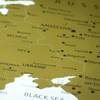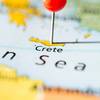U.S. Naval forces disrupted a pirate attack on M/V Falcon Trader II, a Philippine-flagged merchant vessel, after it reported it had been attacked by pirates March 24. All 20 Filipino crew members of the Falcon Trader II are safe and in control of the vessel. At approximately 10:30 a.m. (local), aircraft carrier USS Enterprise (CVN 65) and guided missile cruiser USS Leyte Gulf (CG 55), conducting operations supporting Operation Enduring Freedom, responded to a distress call from the M/V Falcon Trader II reporting that suspected pirates in a small skiff were attempting to board the vessel.
In a second report from the crew of Falcon Trader II, they stated there were pirates aboard and that all 20 crew members were safe and had locked themselves into a safe room, also known as a citadel. The citadel is a secure room with food, water, communication and control over the vessel's steering and propulsion.
A SH-60F helicopter assigned to the "Dragonslayers" of Helicopter Anti-submarine Squadron (HS) 11 from the Enterprise and a SH-60B helicopter assigned to the "Vipers" of Helicopter Anti-Submarine Squadron Light (HSL) 48 from the Leyte Gulf were sent to investigate the situation.
Once on scene, the HS-11 helicopter fired warning shots to dissuade the pirates from continuing their attack. Following this, two pirates were witnessed jumping off the bow of the M/V Falcon Trader II and the pirates' skiff fled the area, pursued by HS-11's helicopter.
As the pirate's skiff was attempting to rendezvous with a larger vessel suspected to be acting as a mother ship, the pirates shot at the helicopter with small arms. The helicopter and its crew were not harmed and returned to continue conducting reconnaissance of the scene.
"We could definitely see the muzzle flashes from their AK-47s, but we weren't hit," said Lt. Joshua A. Overn, a pilot aboard the helicopter. "The anti-piracy training we had received kicked in, and everyone conducted themselves with poise and professionalism."
With no confirmation that all the pirates had left the vessel, a Leyte Gulf crewmember fluent in the Filipino language, Tagalog, remained in contact with the Falcon Trader's crew in the citadel and monitored the vessel overnight. The following morning, after observing no suspicious activity, Leyte Gulf's visit, board, search and seizure team boarded and secured the vessel. Confirming no pirates remained aboard, they notified the crew that it was safe to come out of the citadel.
"It says a great deal about the inherent flexibility and capability of the Enterprise Strike Group that we were able to conduct counter-piracy operations while simultaneously flying Operation Enduring Freedom missions and coordinating air defense of the region," said Capt. Eugene Black, commanding officer of Leyte Gulf.
U.S. forces continue to monitor the suspected pirate mother ship. Pirates are known to keep hostages onboard mother ships to prevent counter-piracy forces from acting directly against them.
"This is a great example of the teamwork inherent in a Carrier Strike Group," said Rear Adm. Terry Kraft, commander of Enterprise Strike Group. "We were lucky to be on scene when the attack occurred, and everyone did their jobs well."















